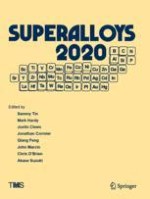2020 | Buch
Superalloys 2020
Proceedings of the 14th International Symposium on Superalloys
herausgegeben von: Sammy Tin, Mark Hardy, Justin Clews, Prof. Dr. Jonathan Cormier, Ph.D. Qiang Feng, John Marcin, Chris O'Brien, Akane Suzuki
Verlag: Springer International Publishing
Buchreihe : The Minerals, Metals & Materials Series
